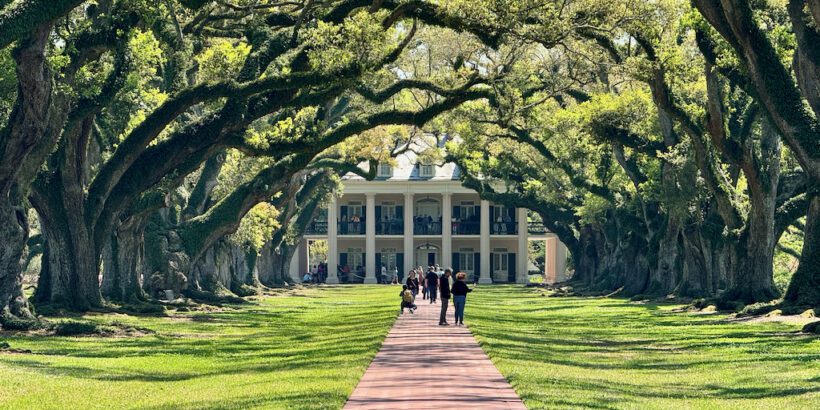Louisiana boasts numerous plantations, with one of the most iconic being Oak Alley Plantation, situated near New Orleans. Renowned for its picturesque setting, Oak Alley also harbors a somber history tied to the institution of slavery.
Below, I’ll give you all the details needed for planning your visit, including insights gained from my own experience at the plantation and the profound lessons learned about its complex past.
Table of Contents
Oak Alley Plantation takeaways
- Most famous plantation in Louisiana located one hour from New Orleans via car
- Known for its picturesque alley of Southern Live Oak trees, featured in many films and TV shows
- Visitors can tour the “Big House” plantation mansion built in the 1830s, as well as the surrounding gardens and grounds, even venturing into re-created slave quarters
- Visitors can arrive directly to the plantation or book a tour with transportation from their hotel
- Tour can be combined with a swamp tour or other adventures
- Visits require approximately two hours though you can wander around the grounds as long as you’d like
What is Oak Alley Plantation?
Oak Alley Plantation is a historic site located in Vacherie, Louisiana, which is about an hour driving time from New Orleans.
It’s renowned for its stunning antebellum architecture and lush surroundings and many appearances in film and other media. The centerpiece of the plantation is its iconic alley of 300-year-old oak trees, forming a picturesque canopy leading to the main house.
Visitors can explore the beautifully preserved mansion, which offers insights into the area’s rich history, including its ties to slavery and sugar cane cultivation.
Today, Oak Alley Plantation serves as a poignant reminder of the complexities of the American South’s past and a popular destination for tourists seeking to immerse themselves in its timeless charm.
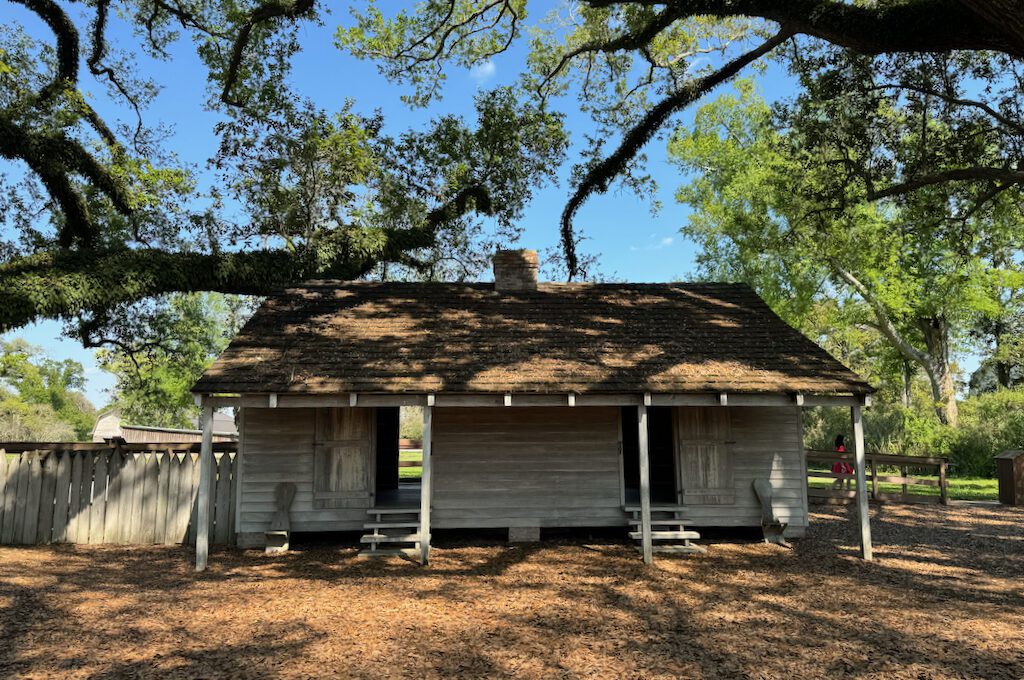
Planning your visit to Oak Alley Plantation
If you want to book a visit to Oak Alley Plantation, I would highly suggest to make reservations as some slots do sell out. In fact, we visited on the weekend and the day before I noticed that several of the time slots were completely sold out. So book ahead if possible.
Visitors to Oak Alley Plantation have the option to choose between two types of tours: the Site with the “Big House” Exhibit ($30) or the Site without it ($27).
With the price difference being minimal, I highly recommend opting for the “Big House” Exhibit tour, which includes a detailed exploration of the mansion on the plantation.
Alternatively, if you choose the other tour, you’ll still have the opportunity to tour the plantation and explore fascinating facilities such as the slave quarters. Either way, your experience promises to be both educational and captivating. Click here to purchase tickets.
If you don’t want to drive to the plantation yourself you can always book a tour that includes transportation. Some of these tours also are packaged with other experiences like swamp tours. There are quite a few tour companies to choose from. We used Cajun Encounters for a swamp tour and they were great for what it’s worth.
Just keep in mind that if you do a package tour you may not be able to spend as much time at the plantation as you would like.
Our experience visiting Oak Alley Plantation
Once you arrive, you will want to head to the ticket booth to get your tickets and/or check in for your tour. They issue you tickets that you have to relinquish but you can always come back for souvenir tickets if you’d like.
In the event you need to use the bathroom there is a bathroom adjacent to the ticket booth area that you can utilize as soon as you enter. (There is also another bathroom near the east garden next to the sugarcane video exhibit if you need to go later on.)
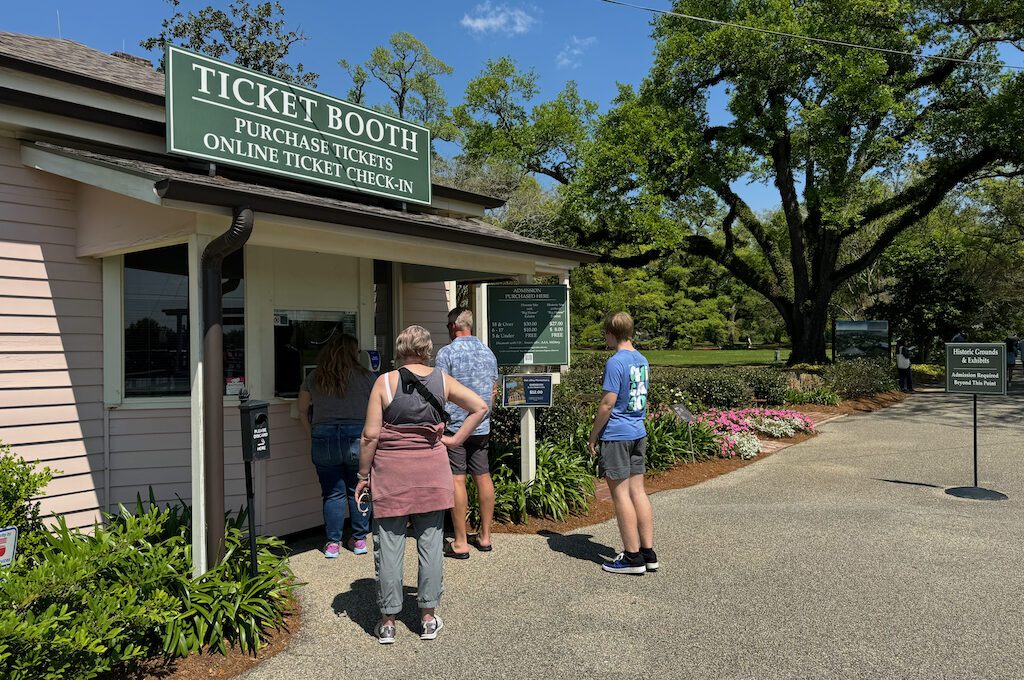
If you get thirsty there is a stand at the Big House where you can purchase water bottles and other drinks including the mint julep (Kentucky Derby drink) which comes both in alcoholic and non-alcoholic versions.
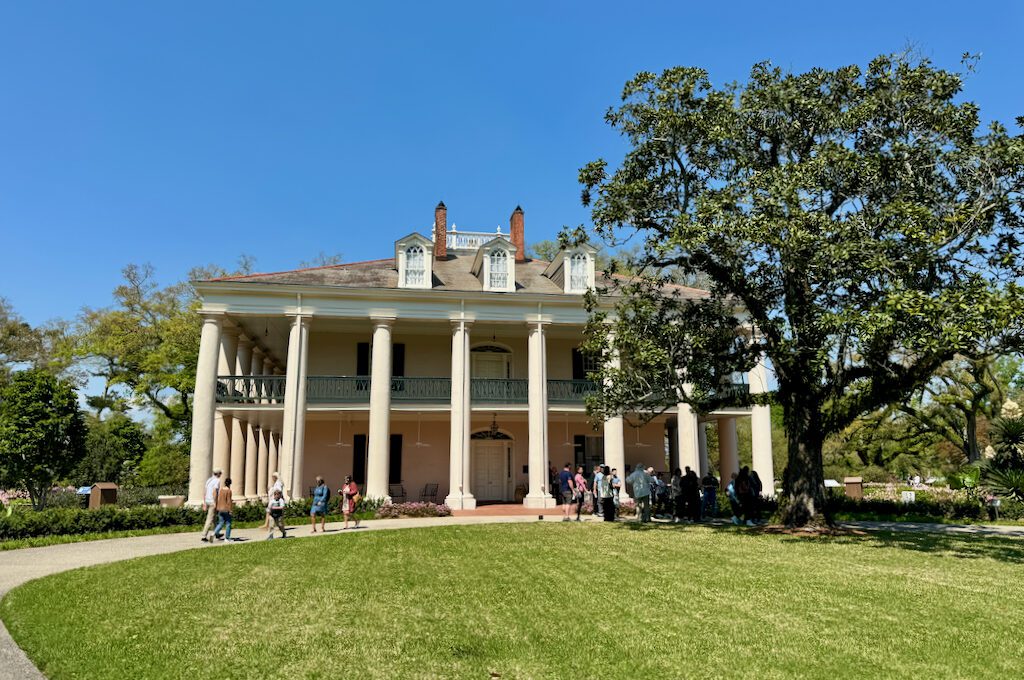
We arrived at about 1:45 PM for a 2:15 PM tour.
We asked if we could be put on the earlier 2PM tour but it was completely sold out so it was not possible. So to kill some time we wandered around and checked out the infamous Oak Alley (known as “The Allée”).
This is the most picturesque portion of the plantation and it consists of a long row of 28 live oak trees (Quercus virginiana) that runs from the mansion all the way to near the Mississippi River.
Some of the trees are pretty massive with trunks as large as 30 feet in circumference and they are believed to be around 300 years old. They are a sight to behold.
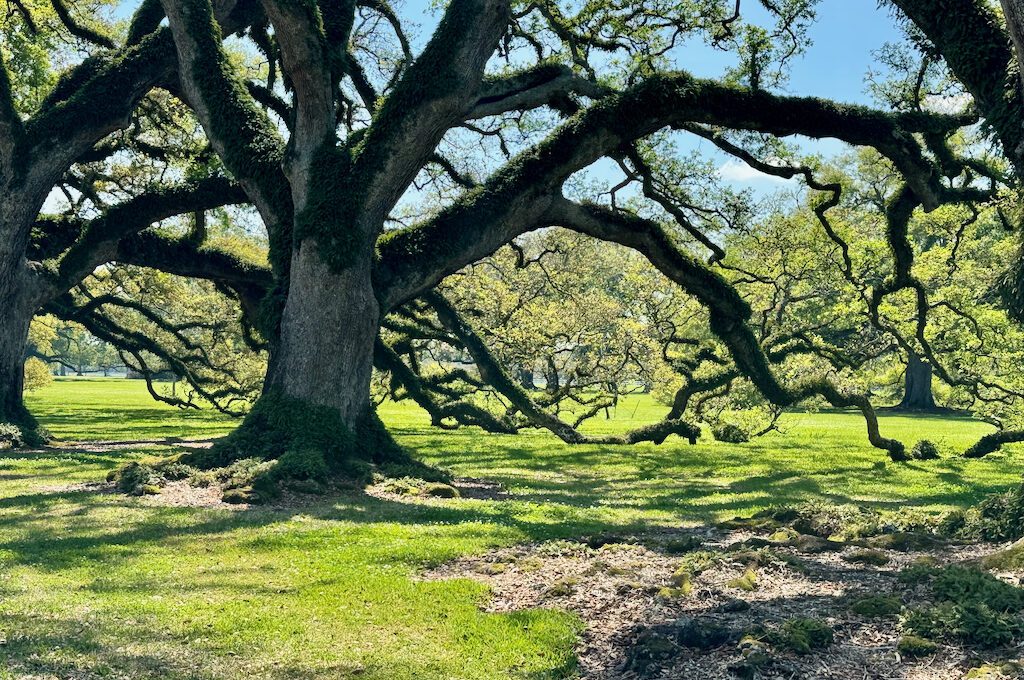
You could see the alley from the outside of the plantation as there is a levee on the banks of the Mississippi River that could give you a view of this but the great thing about doing a tour is you get to walk through this stunning canopy of trees.
You’ll likely recall the scenery from different movies like Interview with a Vampire. It’s been featured in pop culture more times than I can count.
Did you know that the Oak Alley plantation is haunted? Legends and ghost stories abound, with visitors and staff reporting eerie encounters and unexplained phenomena throughout the historic property.
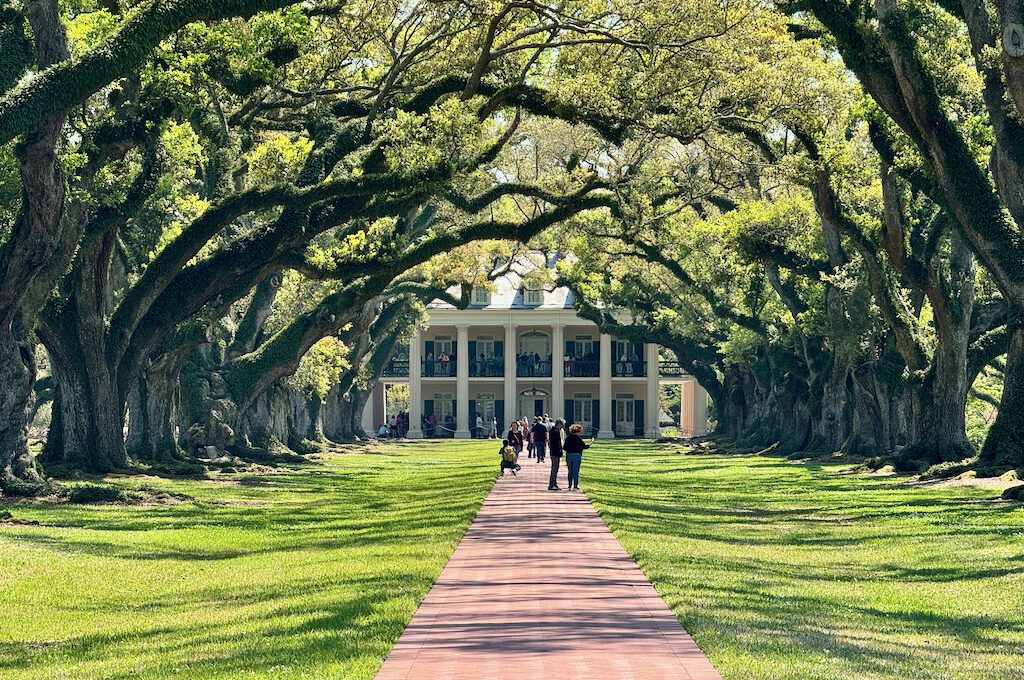
After strolling up and down the alley and checking out the views it was time to show up for the tour of the mansion. It’s a beautiful structure which showcases impressive Greek Revival architecture and a colonnade of 28 Doric columns (that match the 28 oak trees in the alley).
Unfortunately, no photos are allowed inside the mansion.
Embarking on the tour, you’re guided through various rooms like the elegant dining area before ascending to the upper floors, catching glimpses of some rooms restricted to doorway viewing.
Note: If anyone in your group has difficulty climbing stairs, it’s important to inform your tour guide so they can accommodate your needs accordingly as the second floor portion of the visit is available on iPads.
Inside, intriguing artifacts offer insights into life for both the enslaved and the plantation owners, enriching your understanding of the house’s history. Exploring, you’ll discover fascinating relics and learn about antiquated contraptions used in daily antebellum life.
Exiting onto the balcony, you’re treated to sweeping views of the sprawling plantation grounds.
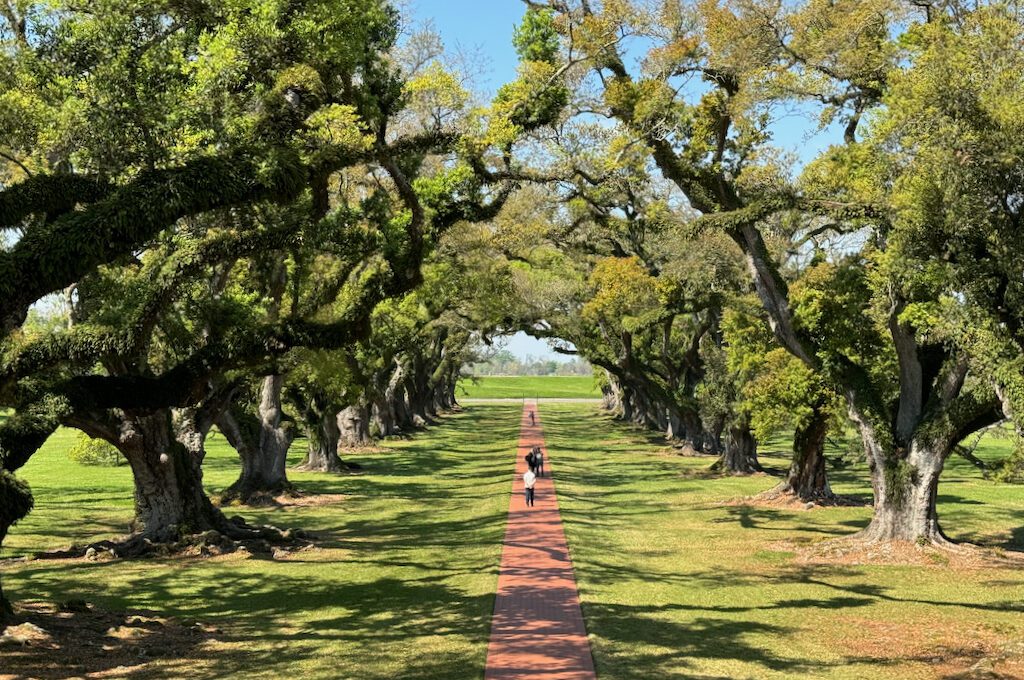
Despite the rapid pace of tours, our knowledgeable guide ensured an enjoyable experience.
I do wish they would’ve gone into some of the details about the historic agricultural innovation of grafting pecan trees that was performed here in 1846 by Antoine, an enslaved gardener.
He created a distinct pecan variety characterized by its exceptionally thin shell, which could be easily broken by one’s bare hand. It’s a pretty interesting story but I didn’t hear it come up during our tour.
Anyway, after we finished up the tour of the mansion we made our way to the other grounds on the plantation.
On one side is the picturesque West Garden, which shares the history and horticulture of Louisiana’s plantation gardens.
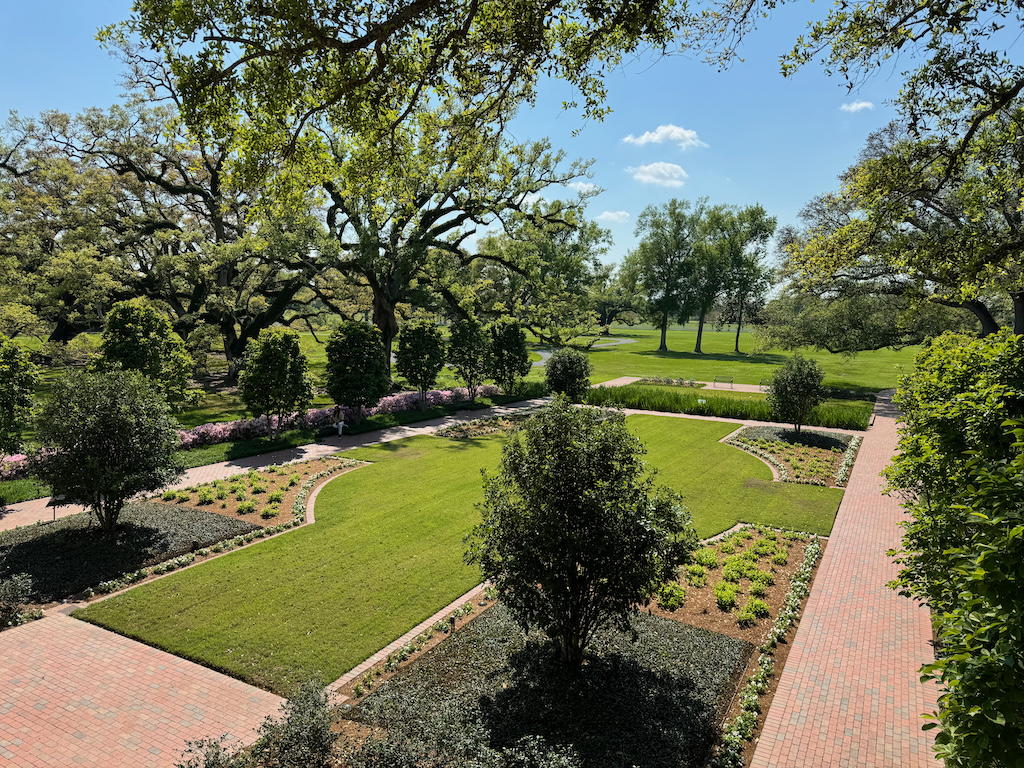
On the other side lies the East Garden, where we encountered an illuminating exhibit on sugarcane plantations. Delving into the intricacies of the manufacturing process, we gained insights into the various stages involved, from cultivation to refinement.
It was great to witness the journey of sugarcane from field to table, offering a deeper appreciation for the plantation’s historical significance.
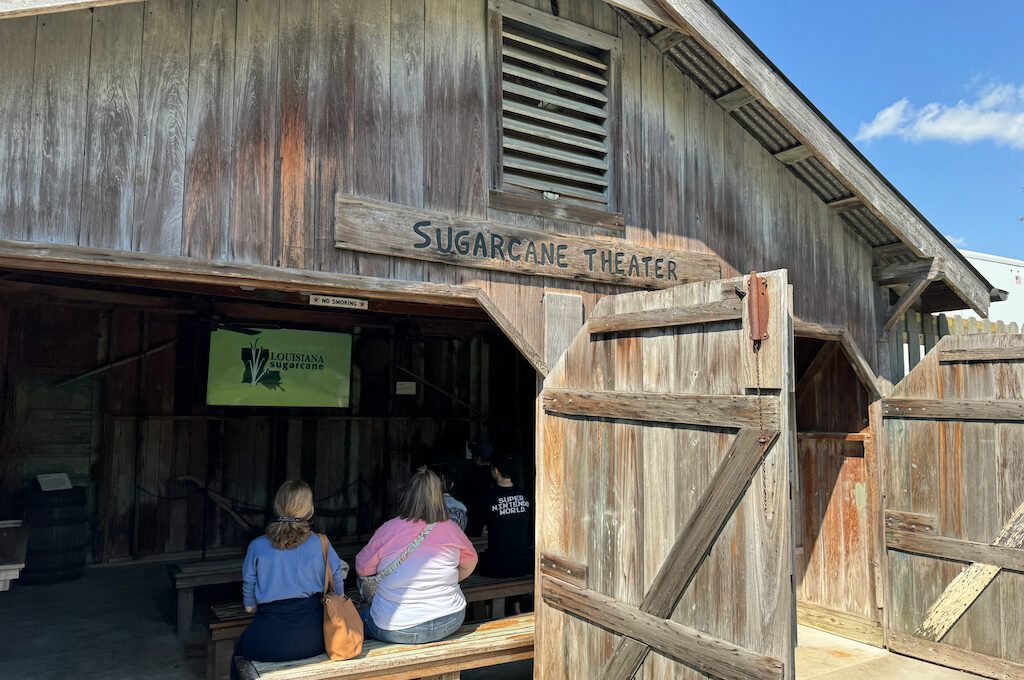
Continuing our journey, we proceeded to the slavery exhibit, where a series of reconstructed slave quarters awaited exploration. Some of these quarters were accessible, allowing us to step inside and gain a visceral understanding of the living conditions endured by enslaved individuals.
It was a poignant and sobering experience, shedding light on the harsh realities of plantation life and deepening our empathy for those who suffered.
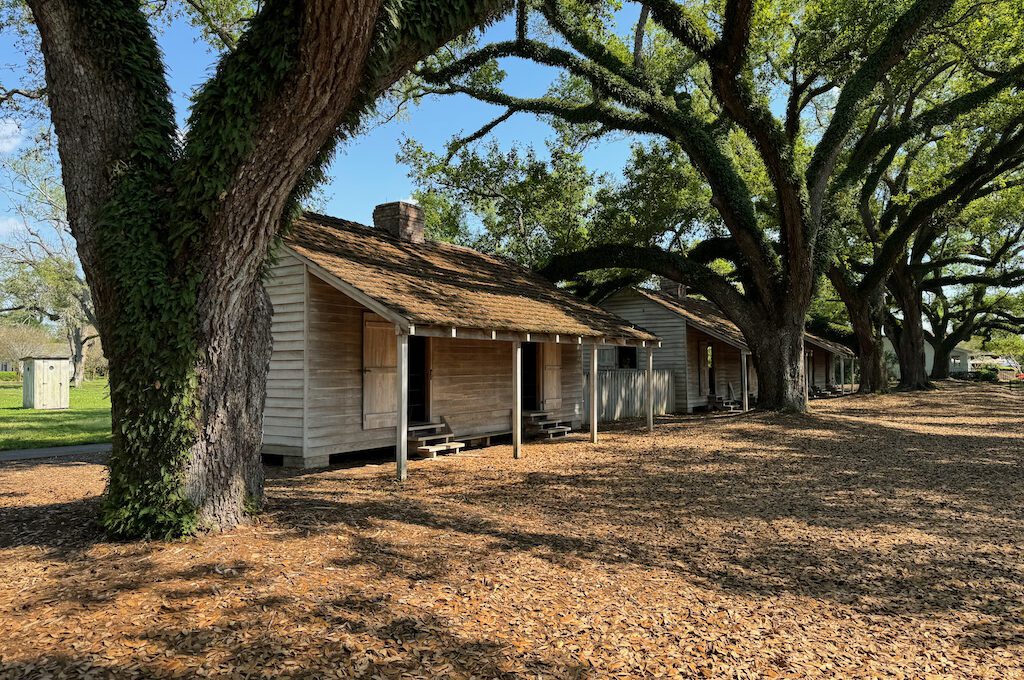
Upon entering, visitors encounter a collection of artifacts, ranging from tools utilized in the fields to various restraint devices used on the enslaved population.
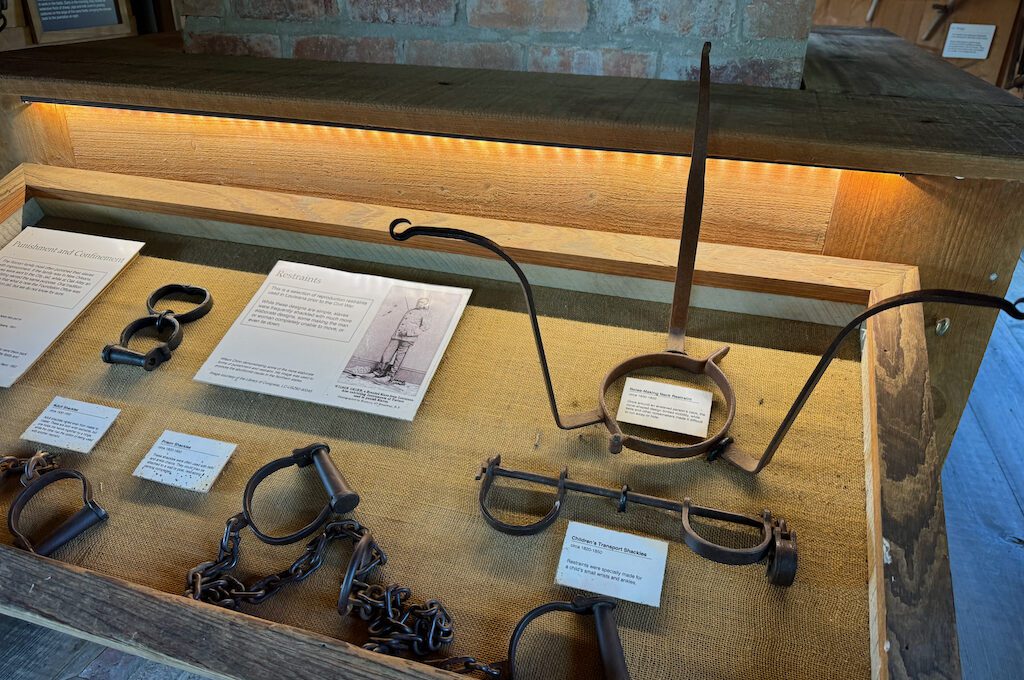
These tangible remnants offer insights into the daily lives and struggles of those who lived and worked at Oak Alley Plantation.
With an average enslaved population of 110 to 120 individuals, plantation Oak Alley Plantation had both “field slaves” and “house slaves.”
Field slaves undertook arduous tasks such as tending to the expansive cane fields, maintenance work, and caring for animals. Enduring demanding 18-hour shifts during harvest season, they exemplified resilience and fortitude amidst challenging circumstances.
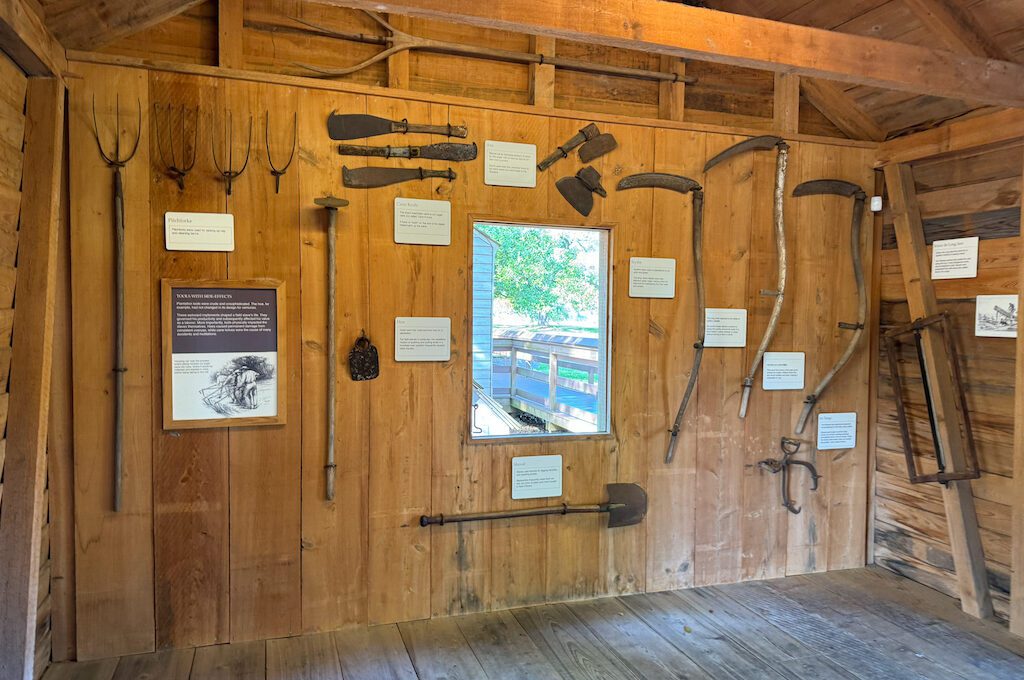
Oak Alley also employed an excessive number of “house slaves,” some as young as 12, who served within the mansion, performing tasks like cooking, cleaning, and childcare.
Referred to as “domestiques,” their abundance served as a conspicuous display of the owner’s wealth and social standing.
Essentially, in the context of plantation society, having fewer slaves engaged in field labor and a larger number serving directly within the mansion was a clear indicator of one’s wealth and elevated social status.
Various interpretive panels thoughtfully guide visitors through this complex history, offering insights into the lives of the enslaved individuals who once inhabited Oak Alley Plantation.
Additionally, a small grove of sugar canes provides a tangible glimpse into the crops that played a central role in shaping this era.
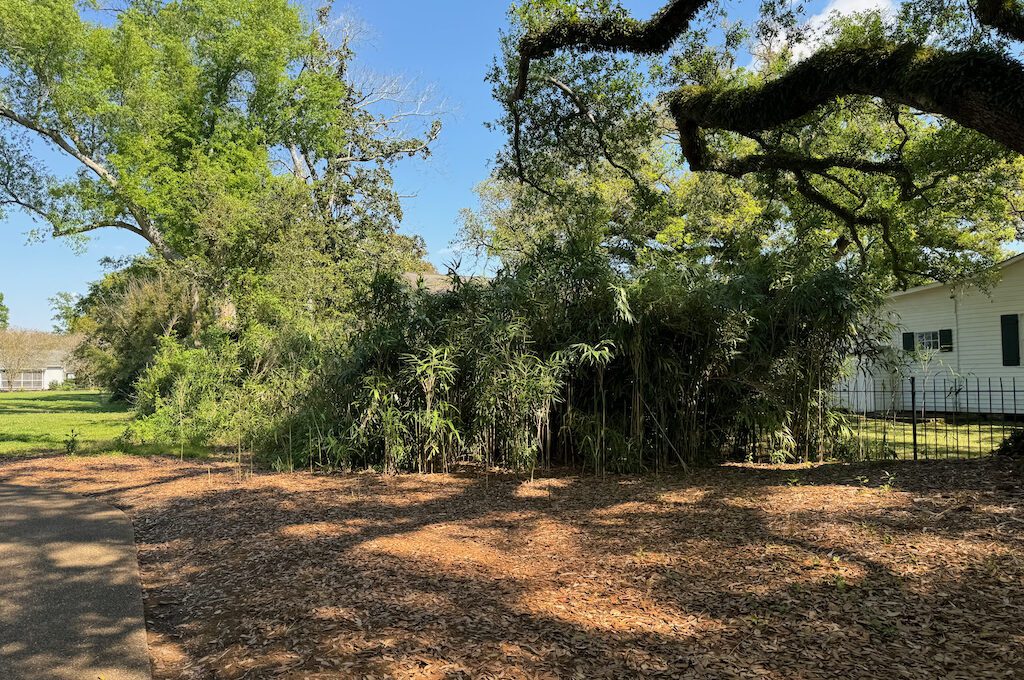
As you navigate through these exhibits, it’s inevitable to confront the somber reality of this dark chapter in human history, evoking a mix of emotions as you contemplate the experiences of those who lived and labored within these grounds.
Eventually, we had to head out to pick up a friend at the airport so we didn’t see everything the plantation head to offer. There are a few other structures to check out like the The Blacksmith Shop, Bachelor housing, and the Stewart family graveyard.
Make sure that you grab a map whenever you arrive and you will be able to see all of the different sites to visit. Also, while the plantation grounds are pretty big there are sign posts directing you where to go so it’s relatively easy to navigate.
By the way if you were looking for a more immersive experience consider visiting the Oak Alley Plantation Restaurant & Inn.
There are cottages you can stay in overnight and there’s also a restaurant serving Southern cuisine like dishes like Crawfish Étouffée over Fried Catfish, Shrimp & Okra Gumbo and the Vacherie Burger. (This is also where you can find the Oak Alley Gift Shop.)
Other Louisiana plantations worth visiting
Oak Alley Plantation is just one of the captivating historic estates nestled near New Orleans, offering a glimpse into the antebellum era.
Just next door is the Felicity Plantation, featured in The Skeleton Key (2005) and 12 Years a Slave (2013).
Among the other notable plantations worth exploring is Laura Plantation, renowned for its Creole heritage and captivating guided tours led by knowledgeable interpreters.
Another must-visit is the Whitney Plantation, dedicated to preserving the stories and experiences of enslaved individuals, providing a poignant and educational perspective on plantation life.
Additionally, St. Joseph Plantation offers an immersive journey through time with its well-preserved main house and informative exhibits.
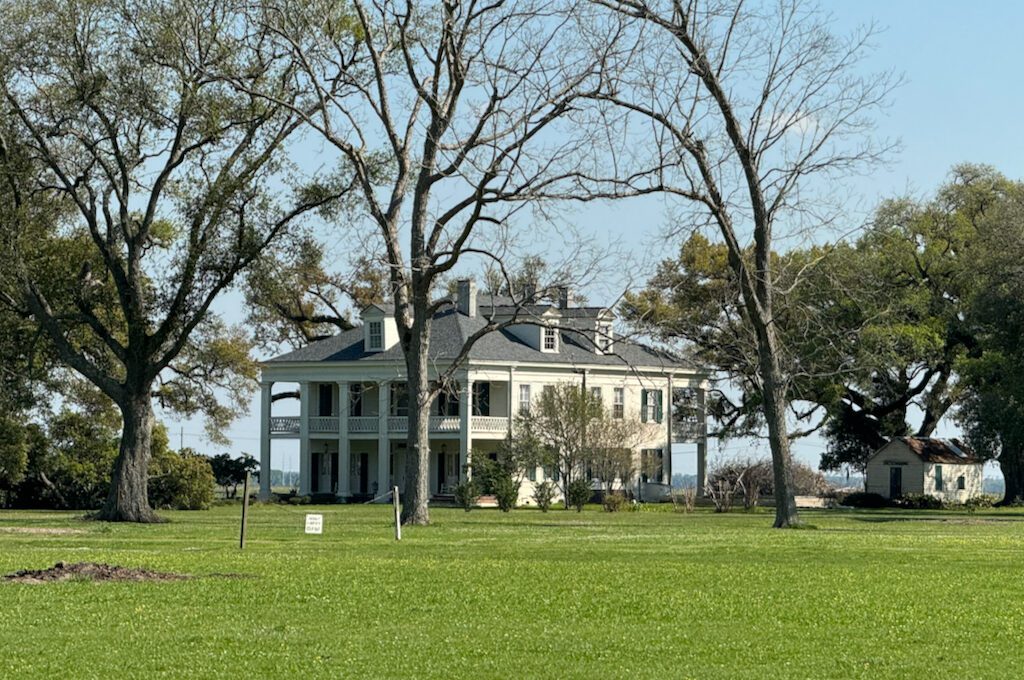
Final word
My visit to Oak Alley Plantation was truly memorable and thought-provoking. The experience evoked a range of emotions, from marveling at its rich history and exquisite architecture to grappling with the sobering realities of slavery.
Despite the complexities of its past, I found the visit to be profoundly worthwhile. It provided a nuanced understanding of the plantation’s significance and left me with a deeper appreciation for the resilience of those who lived and labored there.
Daniel Gillaspia is the Founder of UponArriving.com and the credit card app, WalletFlo. He is a former attorney turned travel expert covering destinations along with TSA, airline, and hotel policies. Since 2014, his content has been featured in publications such as National Geographic, Smithsonian Magazine, and CNBC. Read my bio.

